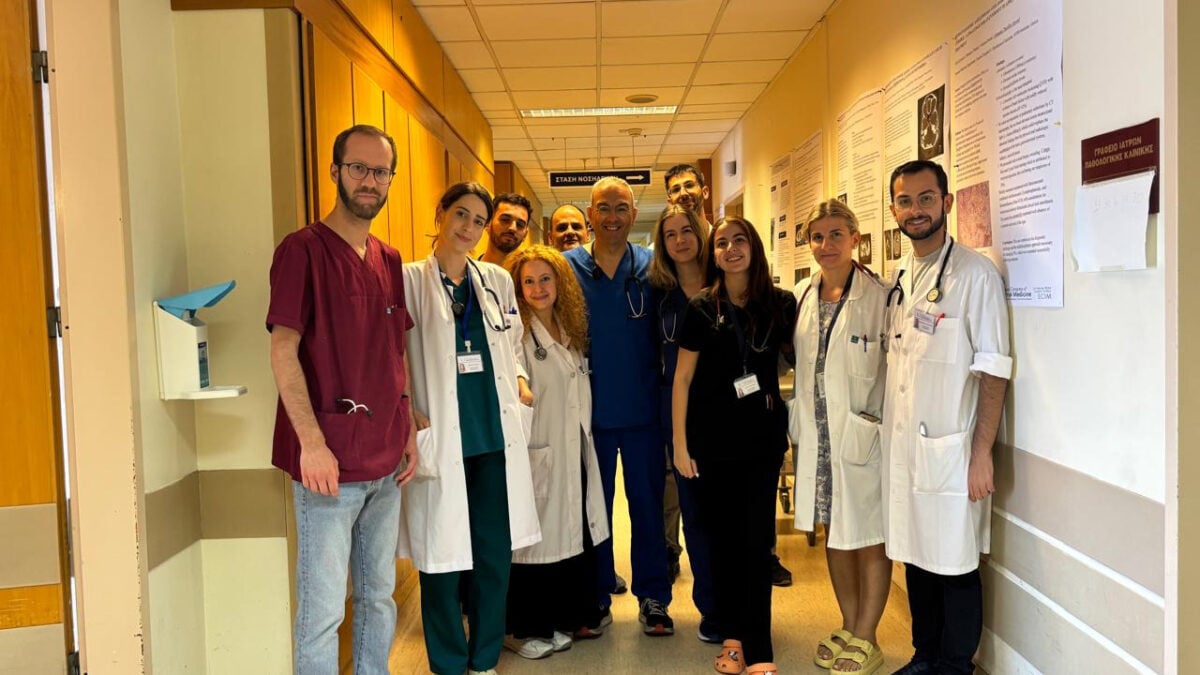The Greek Small Town Doctor Who Knows AI’s Secrets

On vacation in Greece since July 17, I figured it was a good opportunity to see how artificial intelligence was perceived in this small European Union country, which sits at the crossroads of Africa, the Middle East, and Europe. My curiosity was amplified by the fact that I was far from the famous islands like Santorini or Mykonos, which are typically overrun by tourists.
The first four days of my trip took me to Ioannina, a town in the country’s northwest, a region of mountaineers and shepherds. Here, unlike the sunbaked islands to the south, the landscape is dominated by lush green forests and imposing mountains. The heat wave sweeping through Greece this mid July has kept many tourists from tackling the area’s hiking trails. Locals also told me that the ongoing war between Israel and Hamas has emptied the region of the thousands of Israeli tourists who usually visit each summer. In Ioannina, if you ask for fish, the waiters give you a look that says, “What are you talking about?” It is a stark reminder that this is not the Greece of mythical beaches, but a world unto itself.
This sense of remoteness made me even more curious. Was the technology that dominates every conversation in New York, in major American companies, and on Wall Street, even a topic of discussion here?
On Monday, July 21, after admiring the sunset over the lake where Ioannina’s residents gather, I found myself at a restaurant with friends of friends. There were four of us, including two locals: a doctor named Thomas Tzimas, a seasoned physician at the local public hospital, and an engineer named Aristotelis Yfantis. After holding back for the first part of the nearly four hour meal, I turned to Dr. Tzimas and asked if he used AI.
He smiled. I immediately felt I had asked the wrong question, that I was projecting my tech saturated reality onto his. Just because my work revolves around AI does not mean everyone else does. But I was wrong. I had just stumbled upon one of the most AI savvy doctors I had ever met. Here, in a small town nestled among the Greek mountains, AI had already infiltrated the public hospital. He was not only using it daily but was also keenly aware of its flaws and had developed his own methods to counter them. His secret, he would tell me, was controlling the AI’s “temperature” to prevent it from inventing facts. Dr. Tzimas, 56, is an Internal medicine specialist. He is the director of the Internal Medicine Department at General Hospital of Ioannina “G. Hatzikosta.”
I might as well tell you right away: do not get Dr. Tzimas started on AI. With his calm and measured voice, he offers an endless stream of analysis on the subject. He walks you through his daily hospital routine, providing a fascinating glimpse into how large language models have been adopted here, and on the ground perspective I often feel is missing from my reporting back in America.
First, Dr. Tzimas dismisses the most common fear. “No, not at all,” the 56 year old says when I ask if he worries about being replaced. “My job involves experience that AI cannot yet replicate. I need to listen to lung, heart, and bowel sounds, palpate patients, and examine them.”
He continues, “While AI might analyze a digital photograph of a skin lesion, it cannot palpate a patient and feel the intensity of pain or guarding. These are qualities that rely on a doctor’s senses, like smelling a patient’s breath to detect diabetic ketoacidosis.”
The key, he told me, is human interaction. Observing a patient’s demeanor and hygiene provides crucial information that an algorithm cannot easily process. “AI helps save time,” he concedes, “but it needs an experienced physician to input those essential details.”
He is also a pragmatist. Any medical profession that does not require a human touch, he insists, is already on the path to being replaced. First on his list is radiology. He says specialists who interpret X-rays and MRIs are becoming obsolete because AI has grown extraordinarily good at spotting lung nodules, fractures, and subtle neurological conditions. Studies published in journals like The Lancet have shown AI models matching or even outperforming human radiologists in identifying cancers on mammograms.
“For an X-ray, there will be only one [specialist] to check to replace ten of them and just confirm what the system has diagnosed,” Dr. Tzimas said. “And it’s easily done on CT scans and MRI scans. Those specialties will soon be replaced by AI.”
Next, he says, are psychotherapists. The explosion of mental health apps and chatbots like Woebot and Wysa are already offering AI driven therapy services. Dr.Tzimas believes these tools are poised to compete directly with human therapists for basic counseling, especially for patients who cannot afford or easily access face to face care.
“In psychoanalysis, you don’t prescribe medications,” he explained. “A psychiatrist that has a severely schizophrenic patient or depressed patient has to prescribe drugs. With therapy, you go talk to them. AI will replace therapists.”
Before I could process that, Dr. Tzimas revealed that some surgeons are also on the chopping block. He is referring to the human operators of surgical robots like Intuitive’s da Vinci system, a multi armed machine that allows surgeons to perform minimally invasive procedures with greater precision. He believes it is only a matter of time before AI directly controls these robots, enabling operations to be performed autonomously.
“Do you know that there are robots who perform surgery nowadays? But they’re controlled by humans,” he said, seeing my surprised look. “Yeah! They can be controlled by AI systems. That’s coming.”
For now, AI has become his invaluable assistant. “My previous boss would write his thoughts on paper, and his secretary would type them out,” he says. “Now, I dictate notes into my iPhone, copy and paste them into an AI system, and it generates a professional email. It also transcribes typed documents from referrals into digital archives, saving me tons of time.”
One of the most complex parts of his job, he tells me, is navigating the politics between medical staff, which requires diplomacy and a delicate balancing act. This is where AI shines. “I use a ‘negotiator GPT’ prompt that makes answers very diplomatic,” he says. “When there’s a conflict among junior doctors, I have to be strict but also prevent further conflict. This AI acts like an accomplished diplomat, helping me craft replies in our communication platform that smooth over issues.”
He also uses it to tailor patient care after a hospital visit. “I believe certain aspects of a dietician’s role, specifically the creation of detailed dietary plans for patients, could be largely automated,” Dr. Tzimas said. “Imagine a patient with cystitis who shouldn’t eat fatty foods, but they don’t know what ‘fatty food’ means. With a nutritional prompting AI, it can issue a detailed diet, explaining that even seemingly lean foods like lamb can be fatty if broiled.”
However, the biggest impact that AI has in his job is in the diagnosis of patient symptoms. Dr. Tzimas uses a recent example of a patient who came to the hospital with a fever, after inhaling dust in a sheep and goat stable. After inputting the symptoms and the results of basic tests, AI identified Q fever as a potential diagnosis. A blood sample was sent to Athens for a specialized test. “Although it came back negative and the final diagnosis was unrelated, the AI system identified Q fever as a potential possibility, which opened our horizons. Without AI, Q fever might not have been on our list,” he said.
His biggest concern is the AI’s configuration. He quickly realized that AI hallucinates, or makes things up, far too often. But the tool is too important to discard. So, to limit these fabrications, he focuses on a specific setting called “temperature.”
“If the temperature of AI is 1, they hallucinate,” he explained. “For the medical field, it has to be 0.3. That makes them so strict, they cannot fantasize things. They stick to the facts.”
Temperature is a parameter in AI language models that controls randomness. A high temperature, near 1.0, encourages AI to be more creative and unpredictable, which is great for writing a poem but potentially dangerous for diagnosing a disease. Lowering the temperature, closer to 0.3, makes AI more focused, deterministic, and fact based, reducing the risk of these hallucinations.
“If you prompt AI with very strict protocols, they do not hallucinate,” Dr. Tzimas said, as I pushed him on the reliability of his tools.
In Ioannina, for Dr. Tzimas, the debate about whether AI will change medicine is irrelevant. It already has. He uses it for diagnosis, staff communication, and even teaching junior doctors. His perspective reveals both the promise and the peril of our AI future. On one hand, therapy, radiology, and surgery may never look the same. On the other, a simple software setting, the difference between a temperature of 1.0 and 0.3, could be the difference between a correct diagnosis and a catastrophic error.
I left the dinner stunned. Seeing a small-town doctor adopting AI so aggressively, I wondered whether the gap between the technology haves and have-nots might grow at a slower pace than I feared. At least in Ioannina, the gap seemed a little less immense.









